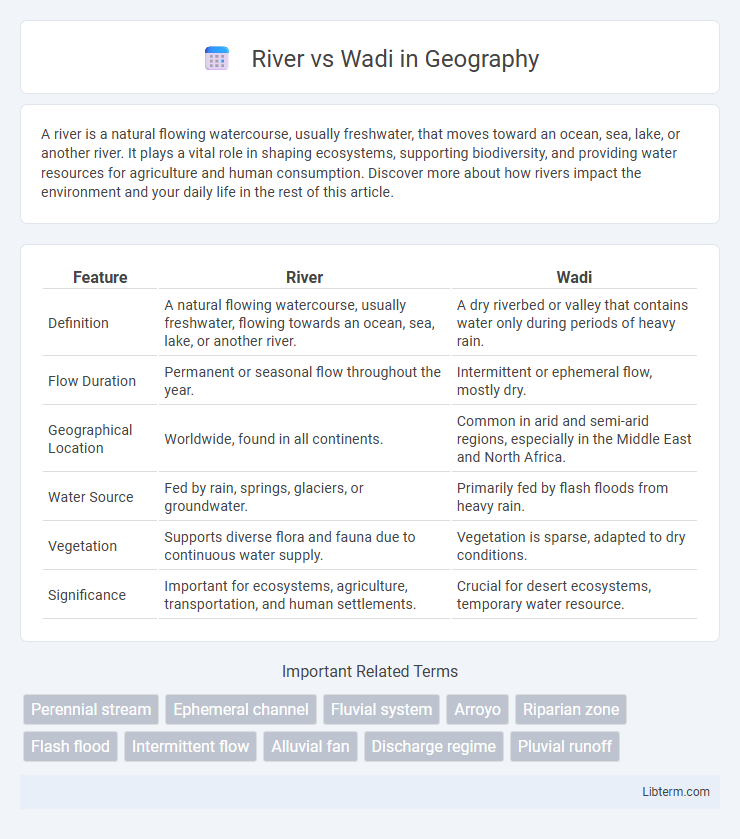A river is a natural flowing watercourse, usually freshwater, that moves toward an ocean, sea, lake, or another river. It plays a vital role in shaping ecosystems, supporting biodiversity, and providing water resources for agriculture and human consumption. Discover more about how rivers impact the environment and your daily life in the rest of this article.
Table of Comparison
| Feature | River | Wadi |
|---|---|---|
| Definition | A natural flowing watercourse, usually freshwater, flowing towards an ocean, sea, lake, or another river. | A dry riverbed or valley that contains water only during periods of heavy rain. |
| Flow Duration | Permanent or seasonal flow throughout the year. | Intermittent or ephemeral flow, mostly dry. |
| Geographical Location | Worldwide, found in all continents. | Common in arid and semi-arid regions, especially in the Middle East and North Africa. |
| Water Source | Fed by rain, springs, glaciers, or groundwater. | Primarily fed by flash floods from heavy rain. |
| Vegetation | Supports diverse flora and fauna due to continuous water supply. | Vegetation is sparse, adapted to dry conditions. |
| Significance | Important for ecosystems, agriculture, transportation, and human settlements. | Crucial for desert ecosystems, temporary water resource. |
Introduction to Rivers and Wadis
A river is a continuous, flowing body of freshwater that moves through a defined channel toward an ocean, sea, lake, or another river, formed by precipitation and groundwater sources. A wadi, primarily found in arid and semi-arid regions, is a dry riverbed or valley that temporarily fills with water during seasonal rains or flash floods. Both rivers and wadis play crucial roles in shaping landscapes, supporting ecosystems, and influencing human settlements, but they differ significantly in their hydrological characteristics and flow permanence.
Definition of River
A river is a natural flowing watercourse, usually freshwater, flowing towards an ocean, sea, lake, or another river. It is characterized by continuous or seasonal flow, contributing to the hydrological cycle and supporting diverse ecosystems. Rivers play a vital role in shaping landscapes, providing water for agriculture, drinking, and industry.
Definition of Wadi
A wadi is a dry valley or riverbed found in arid and semi-arid regions, which only contains water during periods of heavy rain or flash floods, distinguishing it from a permanent river. Unlike rivers, which have continuous flow throughout the year, wadis remain dry most of the time and serve as temporary channels for runoff. The geological and climatic conditions of wadis reflect their intermittent hydrological nature, impacting local ecosystems and human settlements.
Formation and Geography
A river is a natural flowing watercourse, usually freshwater, formed by precipitation runoff, groundwater springs, or melting snow, carving valleys and shaping landscapes over time. In contrast, a wadi is a dry riverbed or valley found primarily in arid and semi-arid regions, formed by intermittent water flow during rare rain events, leading to sudden and temporary streams. Rivers typically have a continuous flow supporting ecosystems and human settlements, while wadis remain dry for extended periods, influencing desert geography and flash flood dynamics.
Climate Impact on Rivers vs Wadis
Rivers, sustained by consistent precipitation and snowmelt, typically maintain perennial flow, whereas wadis, found in arid and semi-arid climates, experience ephemeral flow patterns triggered mainly by sporadic rainfall events. Climate factors like temperature increases and altered precipitation patterns intensify drought frequency, reducing river discharge and transforming some perennial rivers into intermittent streams. Wadis are highly sensitive to climate variability, as flash floods become more intense yet less frequent, causing extreme erosion and sediment transport in desert ecosystems.
Seasonal Differences
Rivers maintain a consistent flow of water throughout the year due to continuous sources like rainfall, springs, or melting snow, supporting diverse ecosystems. Wadis, found primarily in arid and semi-arid regions, remain dry for most of the year and experience sudden, short-lived water flow during seasonal rains or flash floods. This stark seasonal difference influences soil moisture, vegetation patterns, and local water availability in these contrasting landforms.
Ecological Significance
Rivers sustain diverse ecosystems by providing continuous freshwater that supports aquatic and terrestrial life, promoting biodiversity and nutrient cycling. Wadis, typically dry riverbeds that fill during seasonal rains, create unique habitats adapted to intermittent water availability, fostering specialized flora and fauna. Both contribute to ecological balance, but rivers generally support more stable and year-round ecological functions compared to the episodic nature of wadis.
Human Settlement and Use
Rivers provide reliable water sources essential for human settlements, supporting agriculture, industry, and domestic needs throughout the year. Wadis, typically dry riverbeds in arid regions, offer seasonal water flow that influences temporary or nomadic settlements and require adaptive water harvesting techniques. The predictability of riverine environments fosters permanent communities, while wadi regions demand innovative water management for sustainable habitation.
Challenges and Environmental Threats
Rivers face challenges such as pollution from industrial runoff, sedimentation, and habitat fragmentation impacting biodiversity and water quality. Wadis, often dry except for seasonal rains, are susceptible to flash floods, soil erosion, and desertification, which threaten fragile ecosystems and agricultural lands. Both systems struggle with water scarcity and climate change effects, exacerbating environmental degradation and reducing water availability for surrounding communities.
Conclusion: Comparing Rivers and Wadis
Rivers are perennial watercourses with continuous flow, primarily fed by precipitation and groundwater, sustaining diverse ecosystems and human activities year-round. Wadis, by contrast, are seasonal or ephemeral riverbeds in arid regions, carrying water only during rare, intense rainfall events, and often remaining dry for most of the year. Understanding their hydrological patterns highlights the crucial role rivers play in supporting biodiversity and agriculture, whereas wadis contribute to desert ecology and flash flood dynamics.
River Infographic

 libterm.com
libterm.com